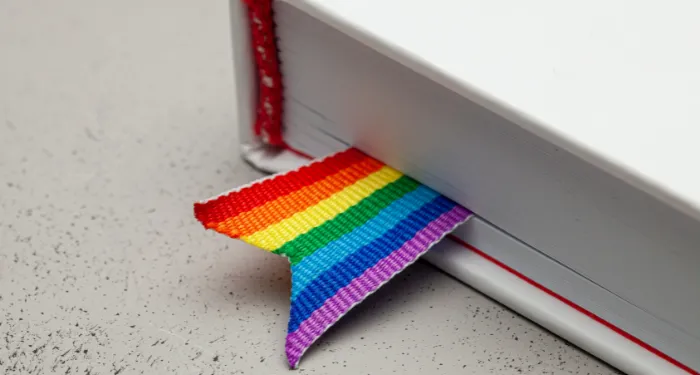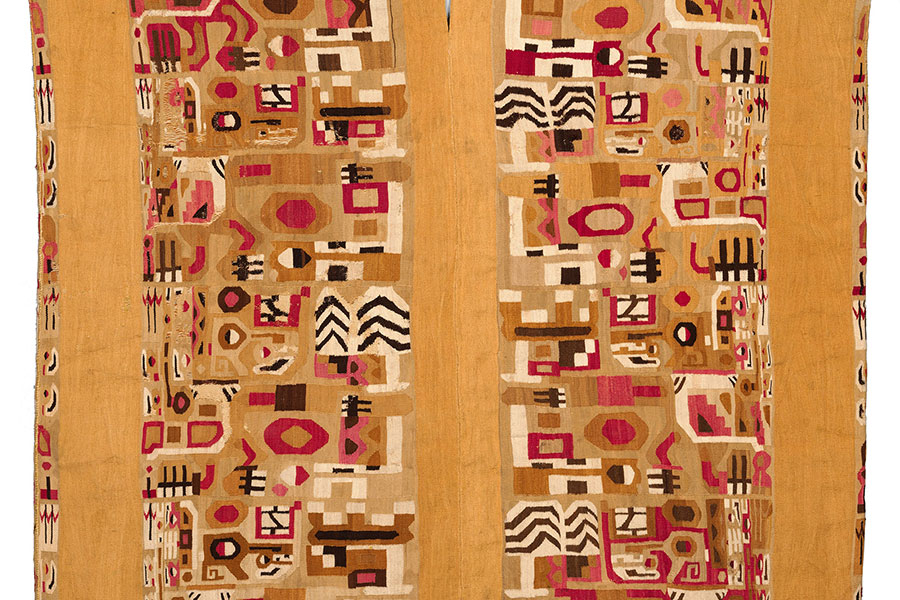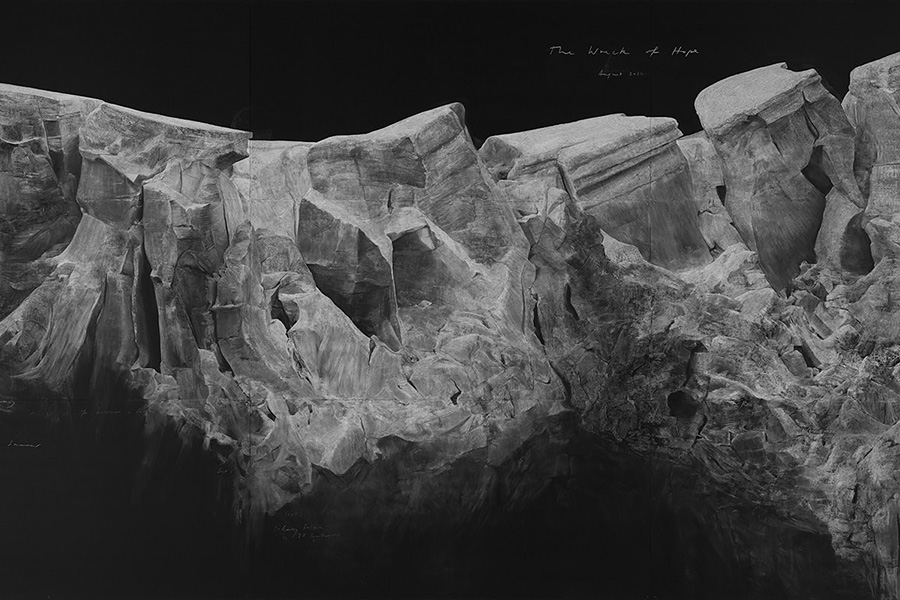In the center of downtown Pittsburgh a tawny metal and smoked glass tower faces the intersection of Grant Street and Fifth Avenue at a diagonal, creating a triangular plaza. Paved with dimpled reddish granite, the plaza has clusters of shin-high octagonal planters around the edges and a group of six chairs at one side. Each chair is a solid piece of an even redder granite flecked with black and cut into what might be described as a squat L shape. While the seat is level, the back reclines perceptibly, about four degrees or so, and its top also slopes downward slightly. The chairs’ surfaces are polished to a mirrored finish that softly reflects the world around them. Their edges are smooth to the touch, so that running a hand or a leg across them is coolly sensual.
Arranged like six equidistant spokes of an absent wheel, the chairs face inward, forming a human-scale space within the plaza. You can sit sideways, throwing an arm over the back to talk with someone in an adjacent chair, or sit facing the entire group, or just look beyond at the traffic and passersby. Around 2:30 on an early November afternoon the plaza was cast in shadow by the hulking courthouse across the street. As the late autumn sun crept slowly into the channel between the buildings, a blade of sunlight hit the farthest chair. One by one they were illuminated in a clockwise arc, casting long tessellated shadows. The granite glimmered, lending an ostentatious glamour to what had seemed understated just moments before. Only the wedge of the plaza with the chairs became lit. Then the sun began to crawl behind a skyscraper on the other side of the street, redrawing its curtain of shadow.
Seeing this unfurl over an hour and a half is like watching an abstract film in which all the elements are nevertheless real. Every feature is perfectly considered—meant to be exactly like that. It’s unusual for anything, much less public seating, to sustain this kind of looking. But if these chairs are conceived as minimal sculptures, what is their relationship to the people sitting on them, checking their phones or waiting for a friend? Where might we locate the boundaries of the “art”—in the physical objects or their arrangement in space? Would it stretch to encompass the entire intersection, people passing, the movement of light, the experience of time? Because paying attention to these instantly recognizable yet unusually eloquent forms makes you aware of all that, and more.
No plaque identifies the chairs as Modular Six-Unit Seating (1985–1986), a work by Scott Burton, whom the late critic Peter Schjeldahl called “the best sculptor ever of things to sit on.” For the past forty years all manner of people have enjoyed chairs, tables, and benches like these on terraces, on esplanades, and in courtyards across North America, without realizing they are part of a radical artistic vision. As the plaza was completed Burton underwent a splenectomy in an attempt to combat the progress of AIDS-related illnesses to which he ultimately succumbed at the age of fifty in 1989. Afterward his “important body of three-dimensional works that have a double identity as sculpture and pieces of furniture,” as his colleague Elizabeth C. Baker characterized it in his obituary in Art in America, slowly faded from both general and art historical awareness, even as installations like the one in Pittsburgh have remained continually in use.
Walter Scott Burton—named for his father and grandfather and in homage to the novelist—was born in Greensboro, Alabama, in 1939, the only child of a secretary and a largely absentee oil driller, and grew up in the rural town of Eutaw. He later recalled dragging dining room chairs into the yard to play house by himself, in what he characterized as a lonely, unhappy childhood. At around the age of thirteen he moved with his mother to Washington, D.C., to be near a beloved uncle who worked as a journalist. There he began taking classes with Leon Berkowitz, a color field painter and the cofounder of the influential Washington Workshop Center, a meeting place and gallery for the Washington Color School artists. Berkowitz and his wife, the poet Ida Fox, became supportive surrogate parents and encouraged Burton at sixteen to travel alone to Provincetown to study with the painter Hans Hofmann, the evangelist of modern art who inspired a generation of artists through his summer workshops. Shy and younger than the other students, Burton nevertheless loved the bohemian atmosphere there and returned for three summers until, in the first of many emphatic decisions, he “stopped painting abruptly and never touched a brush again,” as he later put it.
In 1959 Burton moved to New York, where he studied literature with Lionel Trilling at Columbia while attempting to write novels, poems, and plays. He began a relationship with the figurative painter John Button, who was a decade older and a close friend of Frank O’Hara, and who ushered Burton into what would later be known as the New York School of poets and painters. (O’Hara’s roommate and sometime lover Joe LeSueur, in his fabulously bitchy 2003 memoir, Digressions on Some Poems by Frank O’Hara, described Burton as “pouty, pint-sized, urchinlike, boyishly attractive.”) John Ashbery and James Schuyler, among other poets, had sidelines writing reviews for ART news under the editorship of Thomas B. Hess, who Ashbery believed gave poets assignments “because they have a fresh approach without unnecessary knowledge about the subject.” Their clarity of language enabled them to recount exactly what they saw, elevating visual description into a form of analysis that helped define American art criticism of the period.
Burton finished an MA in English literature at NYU with a focus on modern drama, and by the mid-1960s he was reviewing for ART news, too, alongside Schjeldahl, Bill Berkson, and Carter Ratcliff, members of the second generation of New York School poet-critics in their mid-twenties. In his reviews Burton argued passionately for the new reductive abstraction but in ways unusual for the time. He saw minimal forms not as rejections of content, wiped clean of thought or feeling, but rather as intense concentrations of it, pressed into transparency like coal into diamond. In his cover story on Tony Smith’s six-foot steel cube Die (1962), for example, he wrote:
What is around it, outdoors as well as in, begins to ‘lead up’ to it, as to a climax. Die is not the elimination or antithesis of expression, but the culmination of expression—like a scream so high it can no longer be heard.
Meaning arises as the thing unfurls into the world.
In 1969 Burton wrote the introductory essay to the curator Harald Szeemann’s exhibition at the Kunsthalle Bern, “Live in Your Head: When Attitudes Become Form,” which codified much of what came to be termed conceptual, process, and postminimal art. In the essay he articulated an underlying generational shift while creating a thesis statement for his future work:
Art has been veritably invaded by life, if life means flux, change, chance, time, unpredictability. Sometimes the only difference between the two is sheer consciousness, the awareness that what seemed to be a stain on the wall is in fact a work of art. Or a trench in the snow, or a pile of scraps, or a hole in the wall, or a hole in the desert.
Burton had developed into a major critical voice, but around 1970 he abruptly stopped writing criticism, as he had stopped painting a decade before, and redirected his considerable energies toward performance art. By then Button had broken up with him, and Burton became closer to a group of younger poets and conceptual artists, including John Perreault and Bernadette Mayer, who were staging events outside of cultural institutions, rejecting hierarchies of value, and reacting against art as a commodity. He walked the crowded streets of New York dressed in “ordinary unremarkable woman’s clothes,” with his ears plugged so he could not hear, and at night down deserted Lispenard Street, fully naked—performances best understood as private investigations of public space.
After years of trying to write plays, Burton admitted that he didn’t have an ear for dialogue or any real interest in plot; instead he arrived at what he called “Literalist Theater,” in which the performer was a living sculptural object—as when he took sleeping pills and slept through a crowded opening on a cot at the Architectural League. Reviving the outmoded theatrical form of tableaux vivants, he staged a number of tightly orchestrated pageants of figures posing in various gestures. Burton explained these works as a psycho-sculptural analysis of space: “In the behavior tableaux what I want people to become aware of is the emotional nature of the number of inches between them, or how a person uses an arm as a barrier to communication.” This culminated in influential performances of his Behavior Tableaux at art museums during the 1970s—notably the Whitney Museum of American Art (1972), the Guggenheim Museum (1976), and the Berkeley Art Museum (1980)—in which configurations of almost identically dressed lean white men (and occasionally a fully nude soloist), seen from a distance like figures on a frieze, slowed ordinary movements to near stasis.
Starting when he was teaching at the University of Iowa in the summer of 1970, Burton also made works using found furniture—he arranged groups of tables and chairs as invisible living and dining rooms in lush fields. In 1972 he repurposed a mass-produced Queen Anne–style chair that had been left in his new apartment, initially painting it bronze and then casting it in bronze—his first sculpture. The material transformation elevated the shapely though cheap chair, aching with anachronism and class aspiration, into heroic statuary, allowing it to stand in for a figure and delineate an absent body, while at the same time remaining an actual, functional piece of furniture. Burton installed it on the sidewalk across from Artists Space on Wooster Street in New York City during an exhibition in 1975; from the gallery he observed how passersby interacted with it. To his delight, as art it remained largely unnoticed—it was another unremarkable piece of trash on the street. Only when someone tried to take it did they realize it was something else—about 250 pounds of something else. (Still, it was taken in at night.)
Burton’s activities of this period are meticulously reconstructed in the first scholarly monograph on his work, Queer Behavior: Scott Burton and Performance Art by the art historian David J. Getsy, who has also edited Scott Burton: Collected Writings on Art and Performance, 1965–1975. His earliest performances were ephemeral and later downplayed by the artist in his usual obstreperous manner, but without them, Getsy maintains, it is impossible to fully grasp the sculptural installations for which he later became known. Getsy’s research convincingly foregrounds Burton’s experiences as a Stonewall-generation gay man, seeing them as crucial for any interpretation of his later abstract forms, in which questions of identity, disguise, and “dissembling” are politically charged and deeply felt. (One detail he uncovered is that Burton was moonlighting as a bartender at the New York City leather bar the Mineshaft and organized a night especially for men who were, like him, under five foot seven. This opens new avenues for thinking about his works in relation to sexuality and physical size, as well as differentials of domination and submission, object and subject.)
The story could be picked up by the sculptures themselves in “Scott Burton: Shape Shift,” the most comprehensive exhibition of the artist’s work in the United States since his death. About thirty-four pieces were exquisitely installed in the Pulitzer Arts Foundation in St. Louis by the independent curator Jess Wilcox, in collaboration with the museum’s Heather Alexis Smith, and were accompanied by a large selection of ephemera and documentation related to Burton’s early work. It would be hard to imagine a more ideal interior for his sculptures than Tadao Ando’s cast concrete volumes—there were no wall texts or labels, only laminated information sheets—bisected by an outdoor reflecting pool where Burton’s Rock Settee (1988–1990) has been permanently installed since 2002.
In these works, arranged nonchronologically, one could trace Burton’s experimentation with “pragmatic structures” from the mid-1970s, first altering found furniture, then engaging with vernacular forms, including a folk art twig table cast in bronze and riffs on the classic Adirondack chair clad in Formica, which inverted expectations of outdoor and indoor pieces. There were chairs made of steel (lacquered hot-rolled and Corten) and pierced and folded aluminum, in addition to varieties of wood and stone. A standout was a resplendent table: a sixty-two-inch-square slab of heavily veined peach onyx atop four rectangular columns, all illuminated by interior fluorescent lights that made the glowing stone roil against its own geometry.
From one to the next their formal invention astonishes, while they remain entirely recognizable as furniture for use. Many were shown in St. Louis on small platforms of varying heights, which prevented anyone from sitting on them and emphasized the sense that they had temporarily stepped out of their functional lives to perform onstage as sculptures in a museum. Several pieces, including the rosy granite Two-Part Chaise (1989) in the outdoor courtyard, encouraged touching, sitting, and lying down. As tables and chairs, their dimensions are something the body already knows (to recast Jasper Johns’s famous description of targets, numbers, and flags) and are always understood in direct relation to a human form. With a rhetorical sleight of hand as subtle as it is provocative, Burton insisted that these were not sculptures disguised as or representing furniture, or vice versa (which would still uphold binaries between high and low, art and life), but that they were vehemently, simultaneously both.
In a 1981 interview Burton was asked, somewhat strangely, “What toys first interested you as a child?” Without hesitation he answered, “A tiny table and chair which were, in fact, not mine but only loaned to me, and in some way all my furniture is some attempt to repossess—to possess—those pieces; that little green table and chair.” This Rosebud-like anecdote goes perhaps too far in explaining his enigmatic Child’s Table and Chair (1978), all eight feet on little casters, painted cream with accents of a pastel primary trio: rose pink, sky blue, butter yellow. Sparkle is introduced by a silver lamé cushion; a mirror is set into the tabletop. One thinks about the solitary, unhappy childhood transformed into a dream—the complexity of a mirror, cool, hard, and fragile, reflecting wherever it’s been rolled, the sitter facing downward at an angle as a way of looking up and out. The interviewer continued, “Because you were anxious about them being taken away from you?” To which Burton replied, “I must have been, because they were my favorite objects, and they were never really mine.” There is a similar subliminal poignancy to his permanent public installations, which is the shared condition of public art: they do not belong to the people using them; there is always the threat they could be taken away.
Throughout the 1980s Burton turned to all-encompassing site-specific installations that seemed to merge all his previously disparate interests and endeavors. By situating his sculptures within a larger environment, he combined his decades of research into emotional and psychological nuances of body language and the organization of social space, infusing the seemingly modest furniture with his queer politics and class consciousness. The result was what he saw as a truly “public art”:
Not because it is necessarily located in public places, but because its content is more than the private history of its maker. It might be called popular art, not because it is a mass art, but because it is not an unpopular art, not a “difficult” or “critical” art.
The fact that Burton was living with AIDS while completing his most ambitious public projects adds another valence, one that has been central to the reengagement with his work and legacy today. In his move from performance to sculpture to public space, his queerness, like his conception of art, continued to expand in scope and implication. While he flaunted his leather-clad personal life among close art world friends, Burton’s public persona in the 1980s became one of consummate professionalism, downplaying his earlier, more queer performance work in the service of realizing his increasingly complex public commissions. There was an undeniable power in making public spaces for strangers to gather during the AIDS crisis, to touch and be touched by objects, when those who suffered were being treated as pariahs, legally and socially excluded from public life while facing their own mortality and that of their friends. Burton’s installations conjure possible communities, the comfort of strangers intersecting but diffused in time.
A crucial measure of an artist’s historical importance is the degree to which subsequent artists enter into a dialogue with the work through their own. In this way Burton reemerges as a surprisingly significant figure for the twenty-first century. For instance, Gordon Hall, a leading artist-theorist of the relation between abstraction and trans experience, used Burton’s quote “the number of inches between them” as the title of their 2017 exhibition, which partly responded to Burton’s permanently installed granite Settee, Bench, and Balustrade (1985) at MIT’s List Visual Arts Center. (Hall and the multimedia artist Brendan Fernandes both staged new performances throughout the Pulitzer exhibition.)
In 2022 the Canadian artist Paul P. and the curator Rui Mateus Amaral published Garden Court, Scott Burton, a book about the artist’s posthumous plaza completed in 1992 in downtown Toronto and lovingly photographed by Scott Treleaven from varying vantages and in shifting weather to capture its continued use. According to Paul P., the cultural amnesia that seems to have enshrouded it is emblematic of the larger history of artists lost to AIDS:
Burton’s all-encompassing plan, which fastidiously considered every detail, from custom litter receptacles to the variety of rocks and vegetation, has been marred by small changes with strong aesthetic and ideological consequences, blunting the razor-edge that distinguished it as a work of art.
Next autumn the artist Oscar Tuazon, in collaboration with Dave Harper of the NYC AIDS memorial, will unveil a revitalized version of Burton’s final public work, created for the fishing piers in Sheepshead Bay, Brooklyn, in 1994—a combination of perforated steel benches, wooden ottomans, light posts, and wind vanes—which was destroyed by Hurricane Sandy in 2012.
Intergenerational dialogue as rescue mission was made explicit by the exhibition “Tableau Vivant” at New York’s SculptureCenter, where the Spanish-born, Berlin-based conceptual artist Álvaro Urbano installed partially deconstructed elements of Burton’s Atrium Furnishment (1986), which occupied the ground floor of Midtown Manhattan’s Equitable Center until it was removed and placed in storage in 2020. Regarded by Burton as his most successful work, it consisted of a central circular planter and a mammoth semicircular bench, both made of a deep green marble riven with snaking striations of stark white and deep black. The bench was studded by four cubic pink onyx lamps and banded by a strip of brass embedded in the tiled floor.
Urbano’s theatrical installation showed the bench in segments, exposing the unpolished sides, which would be invisible if it were properly installed. Arrayed amid a plethora of painted trompe l’oeil metal sculptures—plants, fallen leaves, half-eaten apples, cigarette butts, and twiggy magnolias—the marble segments were transposed into a stage set purportedly conjuring the Ramble, Central Park’s historic cruising ground. Overhead was a translucent drop ceiling backlit by an automated dusky light show, complete with silhouettes of fallen leaves and fake dying moths that sputtered intermittently. The effect was almost abject, which was the point: Burton’s precarious legacy, potentially lost, contemplated as artificial ruin. (Urbano’s installation contrasts with the elegance of Burton’s final curatorial provocation, in which he argued for what he termed Brancusi’s “pedestal-tables” as independent sculptures at the inaugural “Artist’s Choice” exhibition at the Museum of Modern Art in 1989.)
As a conceptual intervention, Urbano’s installation dramatized fundamental questions about Burton’s art, and by extension public art as a whole: Can a work so scrupulously crafted to a specific site be salvaged and reinstalled, or has its integrity as an artwork been irrevocably compromised? What kind of effort—intellectual, artistic, curatorial, legal, financial, administrative—is necessary to protect these pieces in such a contested and valuable commodity as our shared space?
In returning to Scott Burton, many of these artists are asking questions about how to address queer and minority identities within visual form without reducing them to mere illustration—questions that in our dawning era of surveillance, censorship, and repression have increasing political urgency. His critics have noted an undeniable, even excessive, eroticism in his objects. Roberta Smith wrote in 1978:
It is safe to say that Burton wants his objects to have charisma, a physical quasi-erotic magnetism that is both fascinating and a little repellent, due to the extent to which it is abstracted and purified (and withheld) by being presented in such formal, material terms.
That exact red granite, cut to those precise angles, polished to this degree of shine—in the relentless specificity of his austere yet sensuous work he provides a model for reclaiming today’s much-maligned “identity art,” marrying the highest feats of form with the grandest political ambition through subtlety, precision, and force. His public installations are meant to be both seen and touched, contemplated and used; they are the product of maniacal control yet are encountered, by his own design, as authorless, almost anonymous.
What is striking about Burton is that his fanatically conceptualized and impeccably rendered works were intended not to overawe but to pleasurably dissolve into ordinary life with subtlety and grace. They aimed to make people’s lives, even momentarily, more pleasant and humane. In language that became a touchstone for David Getsy’s scholarly work, Burton once put it this way:
Any chair is useful but a very striking looking chair—something that isn’t like a usual chair—can make people perhaps more flexible in their attitudes to accept more things—to become more democratic about what a chair is. They may even become more democratic about what a person is.
Therein lie the politics and promise of his art: that things can be different than they seem—that in fact they already are different, and the utopian glimmer of that different is better. Burton sets the stage for you to sit down long enough to think—knowing that important realizations might arise while you are having lunch, waiting for the bus, or simply noticing how the light is changing all the time.


















 English (US) ·
English (US) ·